[4 Ways] How to Remove Write Protection from USB in Windows
When you encounter the 'disk is write protected' error on USB or other devices, you won't be able to make changes on your drive. To resolve this issue, you can try removing write protection in 5 different ways, or if all else fails, consider using deep file recovery software to restore all your files.
Don't panic if you see the "The disk is write protected" error for your USB drive - it can be fixed. You can either remove the write protection or use another disk, which works for USB drives, SD cards, internal, and external hard drives.
Part 1. How to Remove Write Protection from USB in Windows 11/10/8/7
To disable write protection on a hard drive or a USB drive in Windows 11/10/8/7, first, open the Disk Management console by searching for it in the Start menu. In the Disk Management console, locate the drive you want to remove write protection from, right-click on it, and select "Change Drive Letter and Paths." In the resulting window, click on the "Remove" button to remove the drive letter.
| Workable Solutions | Step-by-step Troubleshooting |
|---|---|
| Method 1. Check Physical Lock Switch | Find the lock switch on either side of the USB...Full steps |
| Method 2. Run Diskpart Command | Open Command Prompt > Type diskpart...Full steps |
| Method 3. Edit Registry | Open Run in Windows 11/10/8/7 > Type Regedit...Full steps |
| Method 4. Turn off BitLocker Partition | Open Windows File Explorer > Right-click...Full steps |
To remove write protection from your USB flash drive, memory card, or computer HDD/SSD, follow the fixes listed from easy to complex. Start by checking if the write protection is enabled on your device, then try removing any write protect tabs or switches. If that doesn't work, try using a write protection removal tool or software, or if you're using a computer, try running a system file checker or disk cleanup tool.
Method 1. Remove Write Protection from USB with Physical Lock Switch
When the physical switch on a USB drive or SD card is locked, it can become write-protected on all devices connected to it. To remove the protection, you can use the physical switch.
Step 1. Locate and turn the physical switch from ON to OFF on your USB or SD card.
Step 2. Connect the unlocked USB or SD card to your computer. Check if the write-protected state disappears.
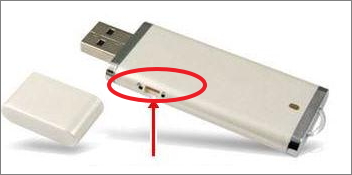
If your USB doesn't have a switch or the system still warns your USB is write-protected, follow Method 2 below to remove the write protection.
Method 2. Remove Write Protection from USB via Diskpart Command
This option clears the read-To make your drive writable, you can simply remove the read-only attribute. This can be done using the command line in Windows, and the process is the same for internal drives, external drives, USB drives, and SD cards. To do this, open Command Prompt as an administrator, navigate to the drive you want to make writable, and use the command `attrib -r` followed by the drive letter (e.
To fix the issue with the Diskpart command, you can use the following steps: Open Command Prompt as an administrator, type "diskpart" and press Enter, then type "list disk" and press Enter to list all the disks on your system, type "select disk" followed by the number of the disk you want to fix, and press Enter, type "clean" and press Enter to clean the disk, type "convert gpt" and press Enter to convert the disk to GPT, and finally type "exit" and press Enter to exit the Diskpart utility. This process will erase all data on the selected disk, so be sure to back up any important files before proceeding.
Step 1. Press Windows + R keys and type cmd in the box that opens. This will launch Command Prompt.
Step 2. Type diskpart in the Command Prompt window and press Enter.
Step 3. Type list disk and press Enter to view the available disks.
Step 4. Type select disk 2 and hit Enter. Replace 2 with the write-protected device number.
Step 5. Type attributes disk clear readonly and hit Enter.
Step 6. Once the write protection removal process completes, type exit to quit diskpart.
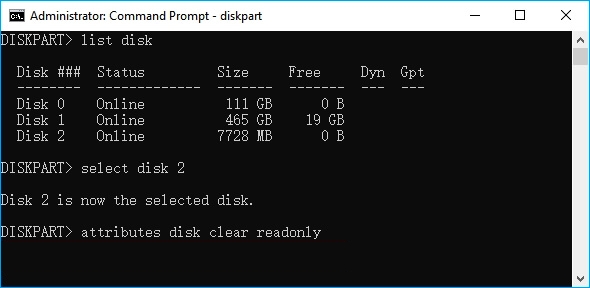
If you're experiencing issues with accessing saved data on your USB or hard drive after a Windows 10 update, try restarting your PC in Safe Mode, then check if the data is accessible. If not, you can try using the "System Restore" feature to revert your system to a previous point when the data was still accessible.
Method 3. Clear Write Protection from USB Devices Using Registry Editor
Registry Editor can also be used to fix write-protected errors on USB, SD, or internal/external HDD/SSD devices. However, this is an advanced procedure and should be used with caution, as incorrect registry tweaks can cause various issues.
Be cautious when using this method to remove write protection on your Windows computer, as it may cause data loss or other issues. To safely remove write protection, you can try using built-in tools like Diskpart or the built-in Windows utility, or third-party software specifically designed for this purpose.
Step 1. Connect your write-protected removable device to the PC.
Step 2. Open the Registry Editor by pressing Windows + R keys, typing regedit in the Run box, and pressing Enter.
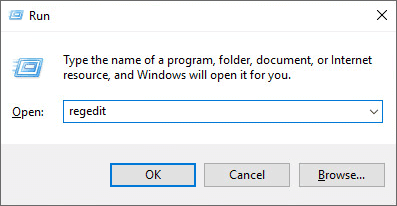
Step 3. Click on HKEY_LOCAL_MACHINE and expand System
Step 4. Click Current Control Set and then click on Control.
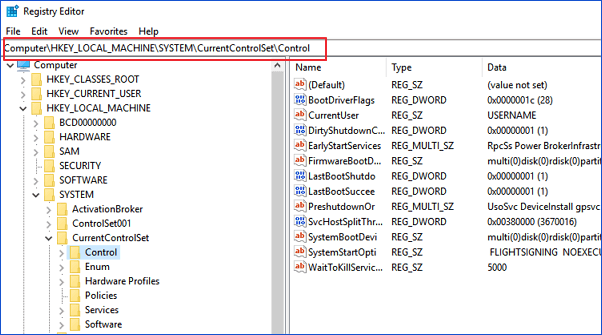
Step 5. Check Storage Device Policies and change the DWORD value to 0. Then, click OK.
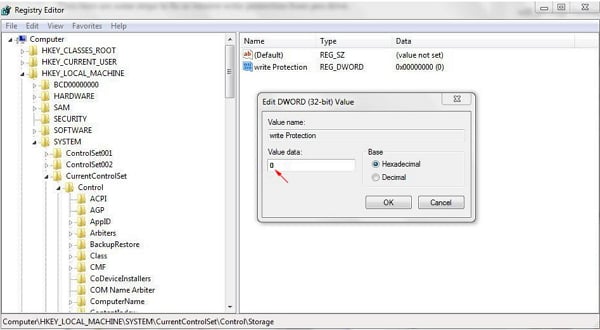
Step 6. Exit the Registry Editor and reboot your PC.
After the restart, check if your device is accessible from the remote location. If it is, then the issue has been resolved. If not, you may need to troubleshoot further or seek additional support.
Method 4. Turn Off BitLocker to Unlock Write Protected USB in Windows 11/10/8/7
When BitLocker is enabled on a hard drive partition, it encrypts the files, requiring removal of protection to make changes.
To unlock a write-protected BitLocker USB or partition, open the Command Prompt as an administrator and type "manage-bde -unlock
Step 1. Open File Explorer, right-click on your BitLocker partition or USB drive, and select Manage BitLocker.

Step 2. Select the locked device and click "Turn off BitLocker".
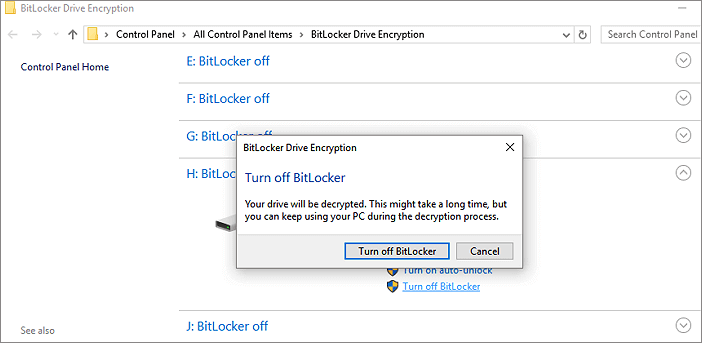
Step 3. Wait for BitLocker to decrypt on its own.
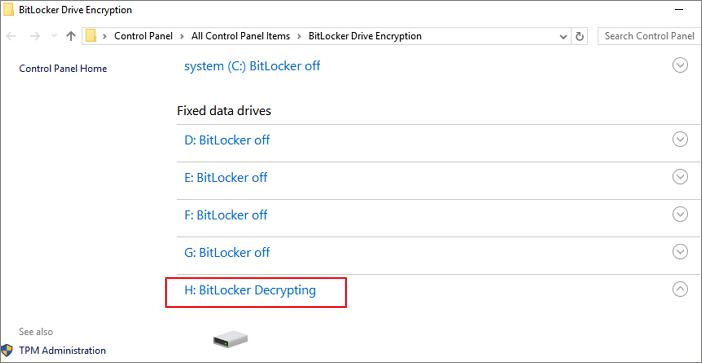
After turning off BitLocker, you can manage data on your USB partition and save new files to it again.
Part 2. Recover Data and Format USB after Write Protection Removal
Once you've removed write protection from your storage devices, you can access files and make changes to your USB flash drive or external USB drive again.
If files were lost or the USB is still inaccessible, you can try using a data recovery software to scan the USB and recover the lost files. Alternatively, you can try using a different computer or USB port to see if the issue is specific to the original computer or port.
#1. Recover Data First If File Lost After Removing USB Write Protection
To recover any lost data during the write protection removal, download Deep Data Recovery.
Step 1: Connect a USB flash drive to your computer. Launch Deep Data Recovery, then select the file types you want to recover. Click "Next" to initiate the process.
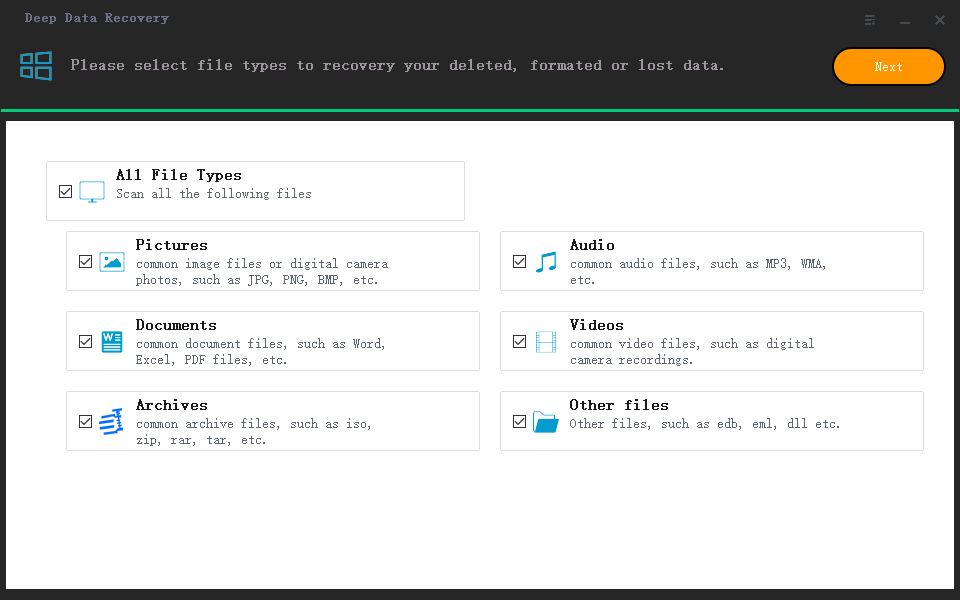
Step 2: Select the USB device. Click "Scan" button to start looking for lost files on PC.
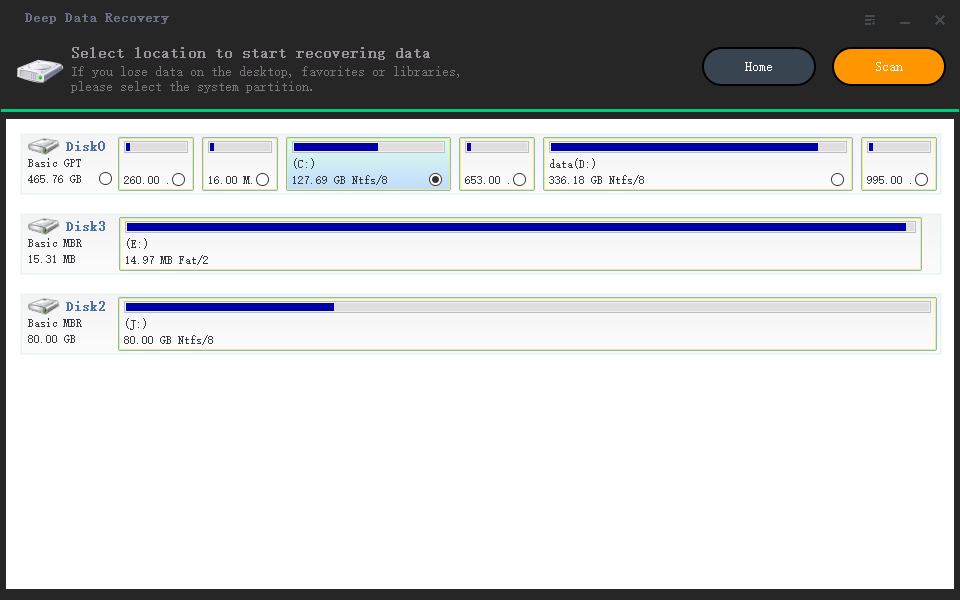
Step 3: After the scan is completed, you can apply the "Filter" feature or click the search box to quickly locate the lost files from the USB drive.
If you need more data to be recovered, click the "Deep Scan" button.
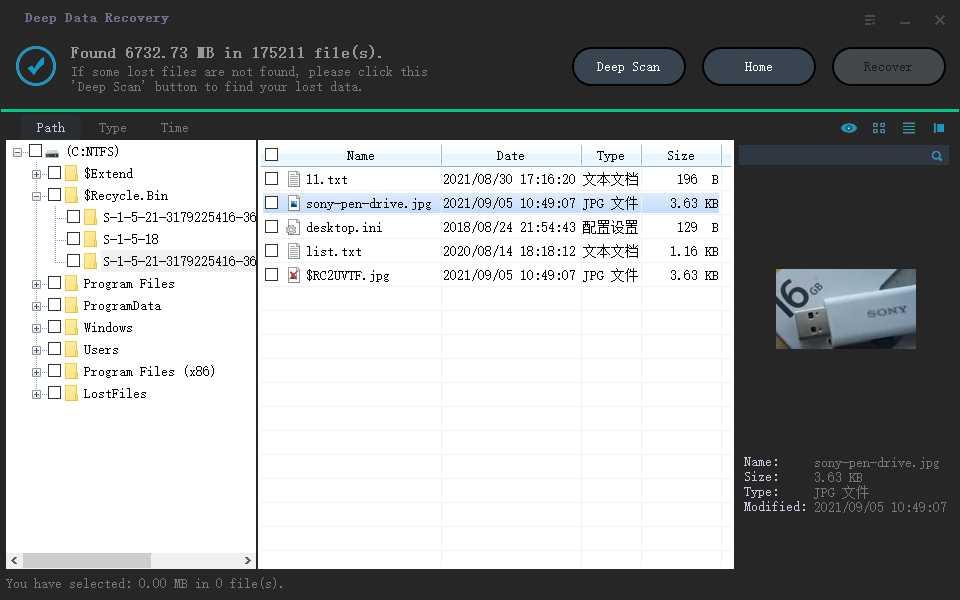
Step 4: Preview the files you want to recover. Click the "Recover" button to restore files.
#2. How to Format USB Drive to NTFS or FAT32
To keep your USB drive in good shape, format it to either NTFS or FAT32 file system.
To format the USB drive, connect it to your computer and format it with Disk Management using the steps below:
Step 1. Open the Run box by pressing Windows + R, type diskmgmt.msc in Run, and hit Enter.
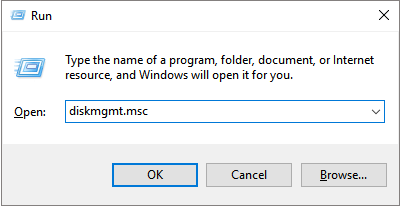
Step 2. Click on Disk Management under Storage, right-click on your USB, and choose Format.
Step 3. Select the format for your USB drive as FAT32 or NTFS and click OK to confirm.
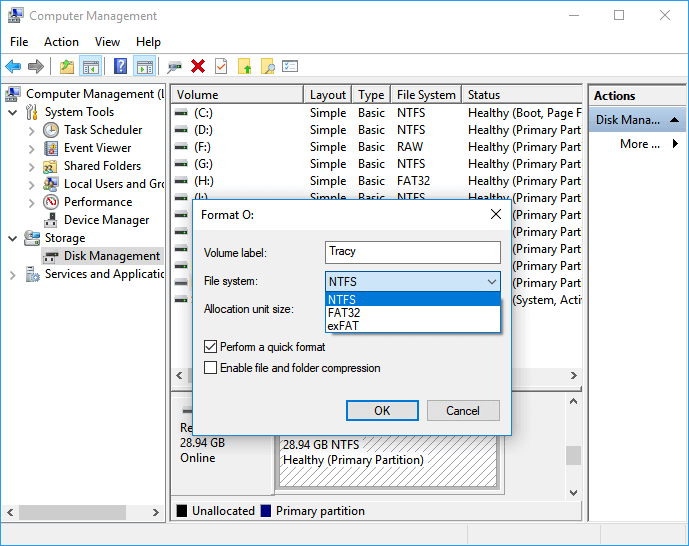
What Caused Write Protection on USB
Storage devices like USB flash drives, SD cards, internal or external hard disks may become write-protected due to various reasons, including accidental settings, software issues, or physical damage, which prevent files from being modified or erased.
- 1. The physical switch of the USB is on the Lockside.
- 2. USB is set as Read-Only by mistake.
- 3. BitLocker protection partition is turned on USB volume.
- 4. A write-protected error on a USB drive is likely caused by third-party encryption software or a virus, which is preventing the disk from being written to.
The only way to resolve the issue is to remove write protection, which can be done by following the complete guide on this page. This will make your device viable for saving and transferring files again.
Conclusion
If you're experiencing write protection issues with a USB, SD, or internal/external hard drive, there are several methods you can try to resolve the problem. You can try using a write protection removal tool, such as a USB write protection removal tool, or a software like EaseUS Partition Master to remove the write protection.
1. To disable the USB or SD card physical switch, you would need to physically switch it to the off state. This typically involves flipping a small switch on the back or side of the device, which may be labeled as a "USB switch" or "SD card switch".
2. Using Diskpart command to clear read only
3. Using USB write protection removal tool
4. Changing registry DWORD value to 0
5. Turning off BitLocker partition encryption
If you're wondering how to remove write protection from a USB drive on Windows 11/10/8/7, the guide above is all you need to remove the write protection.
People Also Ask
Below, we have listed some frequently asked questions and their answers to help you remove write protection from your storage devices.
1. How to remove write protection from the Micro SD card?
To remove write protection from your SD card, you can try using a card reader to access the SD card on another device, or use a file manager app on an Android device to remove the write protection. Alternatively, you can try using a software tool like SD Formatter to format the SD card and remove any write protection.
1. Run Command Prompt as administrator.
2. Type diskpart.exe.
3. Type list disk.
4. Type select disk 0. (0 -- disk number)
5. Type attributes disk clear readonly.
To remove write protection from an SD card, start by checking if the write protection is enabled on the card itself or on the device it's inserted into. If it's on the card, look for a small switch or button on the card that needs to be moved to the "unlocked" position.
2. How can I remove the write protection from a single file?
If your file or folder is locked with a read-only state, you can unlock it by checking the file's properties, looking for a lock icon or a read-only attribute, and then removing the checkmark or attribute to make it writable again. Alternatively, you can try running the command prompt as an administrator and using the "icacls" command to modify the permissions and remove the read-only attribute.
1. Right-click on the folder, select Properties.
2. On the General tab, uncheck the box next to Read-only in the Attributes section.
3. Click OK.
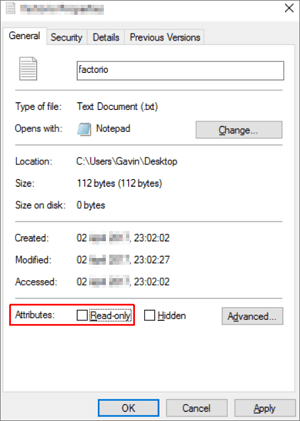
3. How do you add write protection to a flash drive?
To enable write protection on a USB flash drive, you can use one of three methods. One option is to use a USB write protector, a small device that can be plugged into the USB port to prevent any data from being written to the drive.
Use USB write-protection switch.
Use diskpart to change read-only settings.
Change security permission in USB properties.
4. How do I remove write protection from Seagate external hard drive?
Connect your Seagate external hard drive to your PC, remember its disk number, and open Command Prompt. Type the following commands one by one and hit Enter each time: `chkdsk /r D:`, `chkdsk /r D:`, `chkdsk /r D:`, `chkdsk /r D:`, `chkdsk /r D:`, `chkdsk /r D:`, `chkdsk /r D:`, `chkdsk /r D:`, `chkdsk /r D:`, `chkdsk /r D:`, `chkdsk /r D:`, `chkdsk /r D:`, `chkdsk /r D:`, `chkdsk /r D:`, `chkdsk /r D:`, `chkdsk /r D:`, `chkdsk /r D:`, `chkdsk /r D:`, `chkdsk /r D:`, `chkdsk /r D:`, `chkdsk /r D:`, `chkdsk /r D:`, `chkdsk /r D:`, `chkdsk /r D:`, `chkdsk /r D:`, `chkdsk /r D:`, `chkdsk /r D:`, `chkdsk /r D:`, `chkdsk /r D:`, `chkdsk /r D:`, `chkdsk /r D:`, `chkdsk /r D:`, `chkdsk /r D:`, `chkdsk /r D:`, `chkdsk /r D:`, `chkdsk /r D:`, `chkdsk /r D:`, `chkdsk /r D:`, `chkdsk /r D:`, `chkdsk /r D:`, `chkdsk /r D:`, `chkdsk /r D:`, `chkdsk /r D:`, `chkdsk /r D:`, `chkdsk /r D:`, `chkdsk /r D:`, `chkdsk /r D:`, `chkdsk /r D:`, `chkdsk /r D:`, `chkdsk /r D:`, `chkdsk /r D:`, `chkdsk /r D
diskpart
list disk
The command to rewrite a Seagate external hard drive that is write-protected is "select disk n" where n is the disk number of the drive. This command is used to specify which disk to rewrite. The disk number can be found by looking at the drive's label or by using the disk management tool in the operating system.
attributes disk clear readonly
Once you're done with the process, if you find any files are missing on the disk, consider using a reliable USB data recovery tool to recover your valuable files.
Related Articles
- Word Recovery for Unsaved, Deleted, and Corrupted Word Documents [Professional Guide]
Whether your Word documents are deleted, unsaved, or corrupted, you can recover them with the help of this tutorial. We offer you the complete guides on recovering unsaved Word documents with the Recover Unsaved Documents feature, recovering deleted Word files with a file recovery tool, and fixing corrupted Word with a Word repair tool. Start in-depth reading now. - Fix External Hard Drive Not Initialized, I/O Device Error
To fix the Disk Unknown Not Initialized error on an external hard disk, you should initialize the disk at first. Some succeed, but some fail due to a successive error message 'the request could not be performed because of an I/O device error'. This page is to solve this type of [external hard disk not initialized I/O error]. - Fallout 4 Accidentally Deleted Saves, How to Recover?
Have you accidentally deleted saves from Fallout 4? This article will teach you how to recover your Fallout 4 accidentally deleted save with Qiling data recovery software. Download this free data recovery software to restore lost data as soon as possible. - MS SQL Error 4064/4062: Cannot Open User Default Database
If the MS SQL database is unavailable at the time of the connection, you may not be able to connect. Instead, you receive error message 4062 or error message 4064 - cannot open user default database. Here, reliable solutions are available. Follow the steps and fix the MS SQL database error manually or using Qiling MS SQL Recovery software.